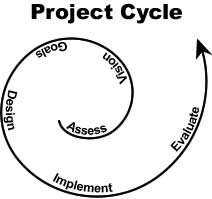
Page 1/9 |
Getting Started:
What are Connected Communities?
Connected Communities have high-speed Internet infrastructure and community members who have the skills and knowledge to use the Internet effectively. These communities understand the economic and social benefits that are possible as a result of being digitally connected.
Connected Communities seek these benefits in different ways. Some want to use digital technologies to enhance their local workforce or attract new workers, tourists or businesses. Others look to the future and seek to provide an environment where their youth will want to return to live and work. Other communities seek to use digital technologies as a way to help build community within their community, using it as a way to help individuals with like interests find and associate with each other.
Broadband service has become a necessary infrastructure for economic and community development in the 21st Century global economy. The availability of affordable broadband services in a community does not ensure the community is truly connected. Connectivity also depends on the ability of organizations and individuals in the community to use the Internet and digital tools (computers, video teleconferencing, etc.) to meet their goals. Leaders in connected communities undertake projects that focus on developing all three components of connectedness:
- Broadband infrastructure
- Adoption and use of digital tools by residents
- Adoption and use of digital tools by organizations
Connected communities are proactive . They are not sitting back ignoring digital opportunities or waiting for the opportunities to come to them. They organize themselves, carefully consider their future, and go after it.
How to Become a Connected Community
 The process of becoming a connected community can take a few months or a number of years. It all depends on what the community leaders want to accomplish. A community that already has a fairly strong broadband infrastructure may spend just a few months educating community members about using the Internet. A community with no broadband connection may need years to design, fund and deploy a high-speed network before moving on to other goals.
The process of becoming a connected community can take a few months or a number of years. It all depends on what the community leaders want to accomplish. A community that already has a fairly strong broadband infrastructure may spend just a few months educating community members about using the Internet. A community with no broadband connection may need years to design, fund and deploy a high-speed network before moving on to other goals.
| No matter the size of the project a community undertakes, the process is the same: Learn, Assess, Vision, Design, Implement, Evaluate. |
Page 1/9 |
Web site and all contents © Copyright SRDC 2009, All rights reserved. |
|
| These materials were developed as part of the Southern Rural Development Center’s National e-Commerce Extension Initiative. They are based upon work supported by the Cooperative State Research, Education, and Extension Service, U.S. Department of Agriculture, under Award No. 2005-45064-03212 Any opinions, findings, conclusions, or recommendations expressed in this publication are those of the author(s) and do not necessarily reflect the view of the U.S. Department of Agriculture or the Southern Rural Development Center. |
|
